Judith with the Head of Holofernes and Judith Holding the Head of Holofernes are names given to two paintings by Cristofano Allori carried out between 1610 and 1613.
Judith with the Head of Holofernes and Judith Holding the Head of Holofernes are names given to two paintings by Cristofano Allori carried out between 1610 and 1613.
One hangs in the Palazzo Pitti in Florence and is dated to between 1610 and 1612. The second is part of the Royal Collection of the United Kingdom and hangs in the Palace of Holyroodhouse in Edinburgh. There are also several copies and numerous prints by other painters and engravers. [1] [2] [3] The painting depicts the account of Judith beheading Holofernes from the deuterocanonical Book of Judith , which was a popular subject in Baroque art.

Baroque painting is the painting associated with the Baroque cultural movement. The movement is often identified with Absolutism, the Counter Reformation and Catholic Revival, but the existence of important Baroque art and architecture in non-absolutist and Protestant states throughout Western Europe underscores its widespread popularity.

The Raphael Cartoons are seven large cartoons for tapestries, surviving from a set of ten cartoons, designed by the High Renaissance painter Raphael in 1515–16, commissioned by Pope Leo X for the Sistine Chapel in the Vatican Palace. The tapestries show scenes from the Gospels and Acts of the Apostles and are hung below the frescoes of the Life of Christ and the Life of Moses commissioned by Pope Sextus. The cartoons belong to the British Royal Collection but since 1865 are on loan to the Victoria and Albert Museum in London.

Cristofano Allori was an Italian painter of the late Florentine Mannerist school, painting mostly portraits and religious subjects.

Orazio Lomi Gentileschi (1563–1639) was an Italian painter. Born in Tuscany, he began his career in Rome, painting in a Mannerist style, much of his work consisting of painting the figures within the decorative schemes of other artists.
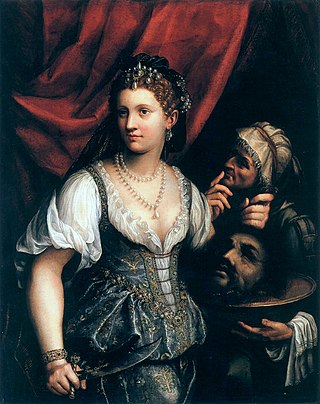
Fede Galizia, better known as Galizia, was an Italian painter of still-lifes, portraits, and religious pictures. She is especially noted as a painter of still-lifes of fruit, a genre in which she was one of the earliest practitioners in European art. She is perhaps not as well known as other female artists, such as Angelica Kauffman and Élisabeth Vigée Le Brun, because she did not have access to court-oriented or aristocratic social circles, nor had she sought the particular patronage of political rulers and noblemen.
Events from the year 1620 in art.

The account of the beheading of Holofernes by Judith is given in the deuterocanonical Book of Judith, and is the subject of many paintings and sculptures from the Renaissance and Baroque periods. In the story, Judith, a beautiful widow, is able to enter the tent of Holofernes because of his desire for her. Holofernes was an Assyrian general who was about to destroy Judith's home, the city of Bethulia. Overcome with drink, he passes out and is decapitated by Judith; his head is taken away in a basket.

Judith Slaying Holofernes is a painting by the Italian early Baroque artist Artemisia Gentileschi, completed in 1612-13 and now at the Museo Capodimonte, Naples, Italy. The picture is considered one of her iconic works. The canvas shows Judith beheading Holofernes. The subject takes an episode from the apocryphal Book of Judith in the Old Testament, which recounts the assassination of the Assyrian general Holofernes by the Israelite heroine Judith. The painting shows the moment when Judith, helped by her maidservant Abra, beheads the general after he has fallen asleep in a drunken stupor. She painted a second version now in the Uffizi, Florence, somewhere between 1613 and 1621.
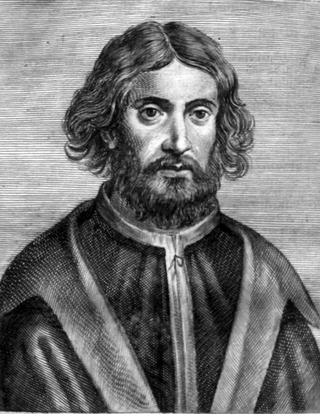
Palma Vecchio, born Jacopo Palma, also known as Jacopo Negretti, was a Venetian painter of the Italian High Renaissance. He is called Palma Vecchio in English and Palma il Vecchio in Italian to distinguish him from Palma il Giovane, his great-nephew, who was also a painter.
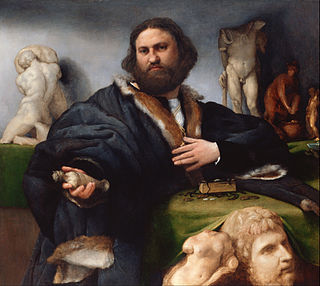
The Portrait of Andrea Odoni is an oil-on-canvas painting by the Italian High Renaissance painter Lorenzo Lotto dated 1527, now in the Royal Collection of the United Kingdom. It hangs in the Picture Gallery in Buckingham Palace, London. The style is typical of Lotto's Venetian period, with denser tones, a softer chromatic range and atmospheric effects at the boundaries. The painting is signed and dated by Lotto.

Salome, or possibly Judith with the Head of Holofernes, is an oil painting which is an early work by the Venetian painter of the late Renaissance, Titian. It is usually thought to represent Salome with the head of John the Baptist. It is usually dated to around 1515 and is now in the Doria Pamphilj Gallery in Rome. Like other paintings of this subject, it has sometimes been considered to represent Judith with the head of Holofernes, the other biblical incident found in art showing a female and a severed male head. Historically, the main figure has also been called Herodias, the mother of Salome.

Shepherd with a flute, or Boy with a Pipe, is a painting in oil on canvas of perhaps 1510–1515, in recent decades usually attributed to Titian, though in the past often to Giorgione. It is now in the Royal Collection in the King's Closet at Windsor Castle. Since at least 1983 it has been called Boy with a Pipe by the Royal Collection; previous titles the collection recognise include Shepherd with a pipe, and The Shepherd.

Louis Finson, Lodewijk Finson or Ludovicus Finsonius was a Flemish painter, draughtsman, copyist and art dealer. He painted portraits, religious compositions, allegorical paintings and genre scenes. Moving to Italy early in his career, he became one of the first Flemish followers of Caravaggio whom he knew personally in Naples. He produced a number of copies after works by Caravaggio. He worked for a number of years in various cities in France where he created altarpieces and portraits. He is known for being the co-owner together with his fellow Flemish painter and business partner Abraham Vinck of two paintings by Caravaggio. Louis Finson played a major role in the Northern Caravaggesque movement through his own works as well as his role as an art dealer.
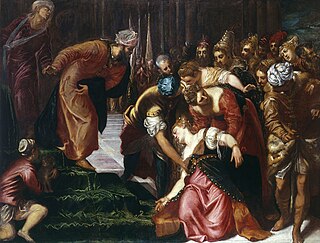
Esther Before Ahasuerus is a large painting of 1546–47 by the Venetian painter Tintoretto showing a scene from the Greek addition to the Book of Esther, in which Queen Esther faints during a bold intervention with her husband King Ahasuerus of Persia. In oil on canvas, it measures 207.7 by 275.5 centimetres. Since the 1620s it has been in the Royal Collection of the United Kingdom, and in 2019 it hung in the King's Gallery in Kensington Palace, London.

Judith and her Maidservant is a c. 1615 painting by the Italian baroque artist Artemisia Gentileschi. The painting depicts Judith and her maidservant leaving the scene where they have just beheaded general Holofernes, whose head is in the basket carried by the maidservant. It hangs in the Pitti Palace, Florence.

Judith and Her Maidservant is one of four paintings by the Italian baroque artist Artemisia Gentileschi that depicts the biblical story of Judith and Holofernes. This particular work, executed in about 1623 to 1625, now hangs in the Detroit Institute of Arts. The narrative is taken from the deuterocanonical Book of Judith, in which Judith seduces and then murders the general Holofernes. This precise moment illustrates the maidservant Abra wrapping the severed head in a bag, moments after the murder, while Judith keeps watch. The other three paintings are now shown in the Museo di Capodimonte in Naples, the Palazzo Pitti in Florence, and the Musée de la Castre in Cannes.

Judith Slaying Holofernes c. 1620, now at the Uffizi Gallery in Florence, is the renowned painting by Baroque artist Artemisia Gentileschi depicting the assassination of Holofernes from the apocryphal Book of Judith. When compared to her earlier interpretation from Naples c. 1612, there are subtle but marked improvements to the composition and detailed elements of the work. These differences display the skill of a cultivated Baroque painter, with the adept use of chiaroscuro and realism to express the violent tension between Judith, Abra, and the dying Holofernes.

The Adoration of the Shepherds by Giovanni Cariani is a panel painting of about 1515-1517, now in the Royal Collection of the United Kingdom. The painting is somewhat damaged, and also seems to have been subject to significant changes of intention during the process of painting. It was one of the large group of paintings bought by Charles I of England from the collection of Vincenzo II, last of the Gonzaga Dukes of Mantua in 1628. The painted surface measures 73.6 cm × 120.3 cm.

Portrait of Jacopo Sannazaro, also known as Portrait of a Man, is an oil painting by the Venetian master Titian, dated to about 1513. It is part of the Royal Collection, and hangs in Buckingham Palace.
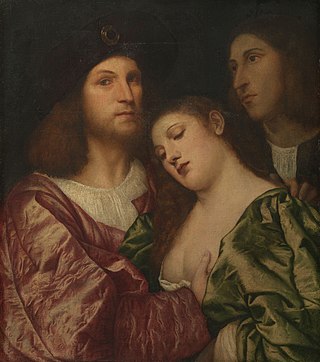
The Lovers, also known by other titles, is an oil painting, sometimes attributed to Titian, and dated to about 1510. The picture is part of the Royal Collection of the United Kingdom and hangs in the King's Dressing Room of Windsor Castle.